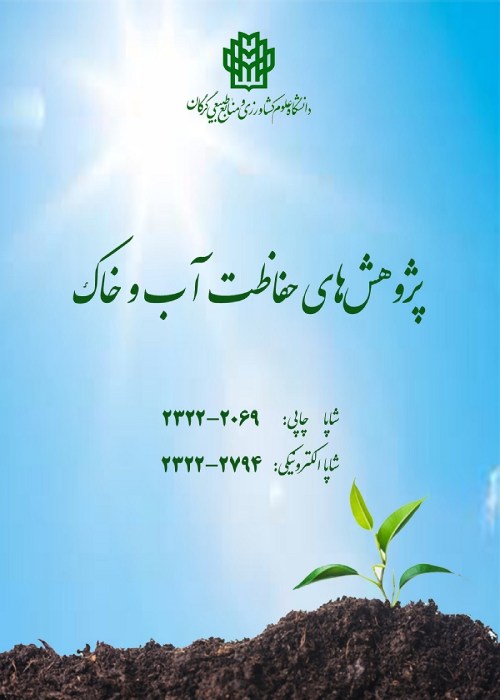Modelling the daily runoff of Nazloo Chai watershed at the west side of Urmia Lake
Author(s):
Abstract:
Background And Objectives
After 1960,s computer revolution, the hydrologic modelling took on a new form and the Stanford watershed model may be considered as one of the early successful attempts in this regard. The rainfall runoff models have always been considered as one of the most effective decision tools in watershed management. In the current study, the Tank daily rainfall runoff model was used in Nazloo Chai river watershed at the west side of Urmia Lake. The importance of the lake hydrologic fluctuations in todays critical situation is obvious to everyone. Knowing the rainfall runoff relations in all sub catchments of the Urmia basin especially in a watershed such as Nazloo which suffers from insufficient number of measurement stations and limited information from those parts of catchment located in Turkey, is so important. As a result, the goal is building a relation between rainfall of catchment and the out let runoff, in order to predict the future amounts of runoff.Materials And Methods
The Nazloo Chai river with almost 93 km length is one of the 13 rivers drops into Urmia lake. The Tank rainfall runoff model is a simple, conceptual and lumped model. The model inputs are precipitation, evaporation, and daily runoff at the outlet of watershed. Among all available gauges, 3 stations with the most acceptable overlapping covered area and longest joint statistical period, 16 years, have been selected. Due to high water withdrawals in the last sub catchment before the watershed outlet, the mentioned sub catchment has been eliminated and the total area of modeled watershed has been decreased. The monthly average of precipitation and evaporation measured data have been compared with long term amounts of these parameters in order to modify the input data and reflect the watershed processes in input data as well. The Tank model is presented along with some other famous rainfall runoff models in RRL software package which has been developed in Australia. The sum of 224 calibrations and verifications by using 7 optimization methods, 8 primary objective functions and 4 secondary objective functions have been done. The model was evaluated by considering Nash and correlation coefficients in each run.Results
Totally about 117 runs from all 224 runs have shown nice fit, and their Nash coefficients were reported between 0 and 1 which is an acceptable range. About 30 cases also had a Nash coefficient more than 0.4 and the graphical fitness between observed and estimated runoffs also confirmed the acceptable fitness. The correlation coefficient was also evaluated and totally confirmed the models which were selected based on Nash coefficient. But due to Nash coefficient advantages compared with correlation coefficient, it was used in current study.Conclusion
It was concluded that the model didnt perfectly simulate the peak discharges and they have been lower estimated. It was determined through field research and historic data evaluation, that the peak discharges occur mostly during April and May in the region. Along with the high rainfall events the snowmelts are also constituent the large part of runoffs at that time. Insufficient number of stations especially in highlands of the region, and the lack of some nodes in model in order to exert snowmelt data, eventuate lower rainfall input data and as a result disable model to simulate peak flows. But generally the base flows were simulated well and the model performance was accepted. Keywords:
Language:
Persian
Published:
Water and Soil Conservation, Volume:23 Issue: 6, 2017
Pages:
123 to 141
magiran.com/p1680452
دانلود و مطالعه متن این مقاله با یکی از روشهای زیر امکان پذیر است:
اشتراک شخصی
با عضویت و پرداخت آنلاین حق اشتراک یکساله به مبلغ 1,390,000ريال میتوانید 70 عنوان مطلب دانلود کنید!
اشتراک سازمانی
به کتابخانه دانشگاه یا محل کار خود پیشنهاد کنید تا اشتراک سازمانی این پایگاه را برای دسترسی نامحدود همه کاربران به متن مطالب تهیه نمایند!
توجه!
- حق عضویت دریافتی صرف حمایت از نشریات عضو و نگهداری، تکمیل و توسعه مگیران میشود.
- پرداخت حق اشتراک و دانلود مقالات اجازه بازنشر آن در سایر رسانههای چاپی و دیجیتال را به کاربر نمیدهد.
In order to view content subscription is required
Personal subscription
Subscribe magiran.com for 70 € euros via PayPal and download 70 articles during a year.
Organization subscription
Please contact us to subscribe your university or library for unlimited access!


